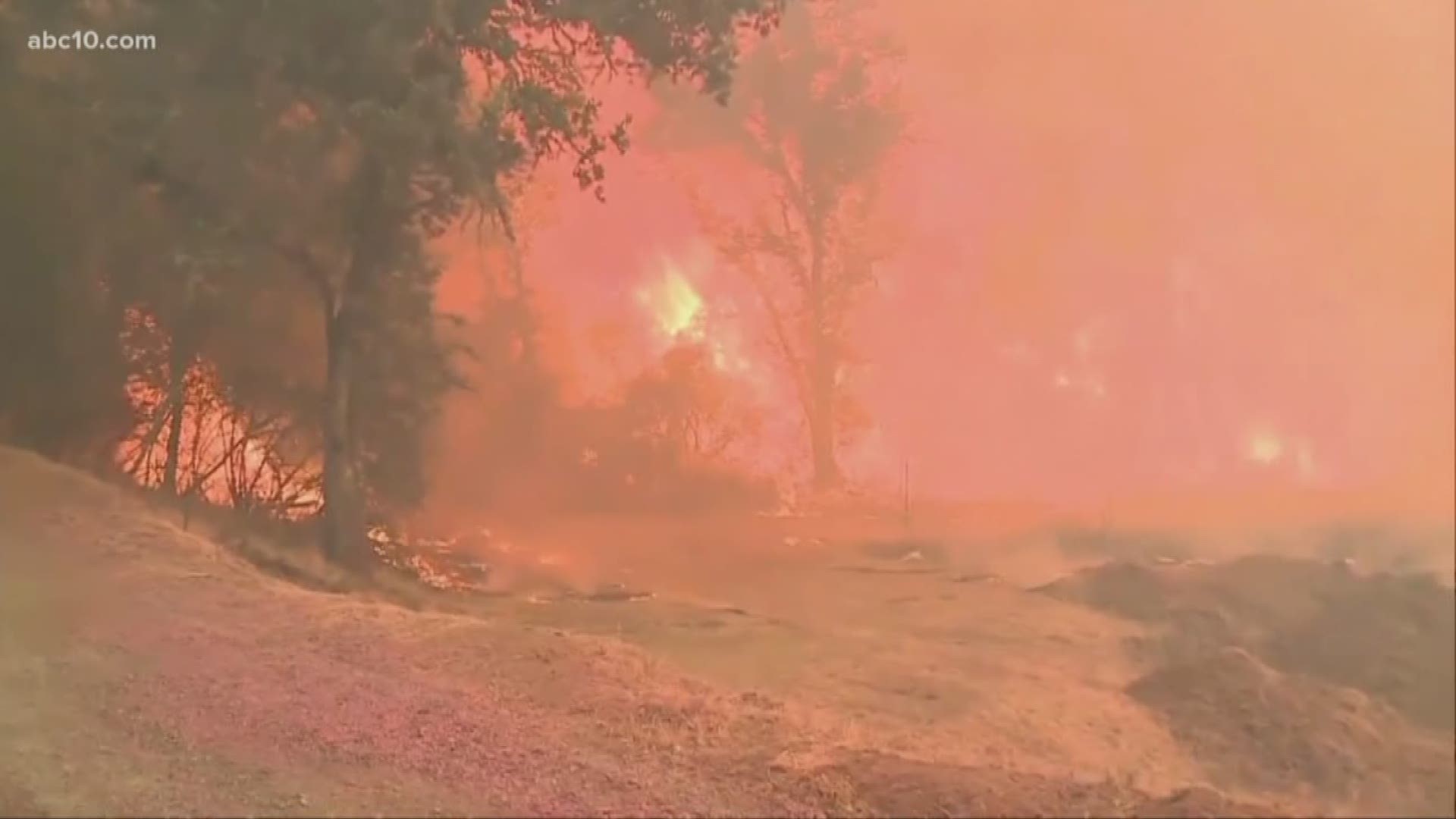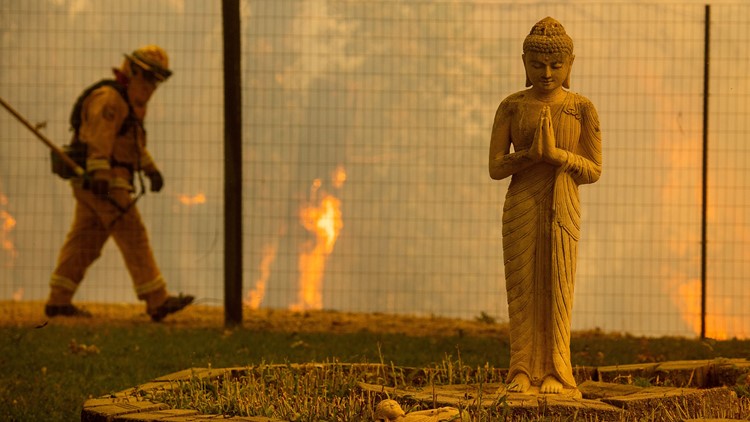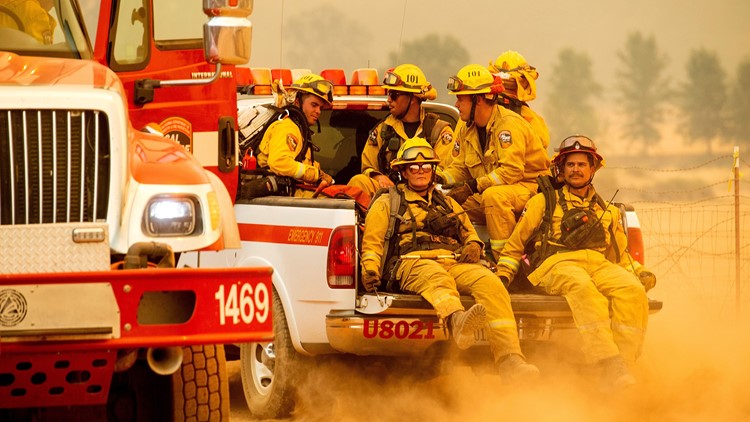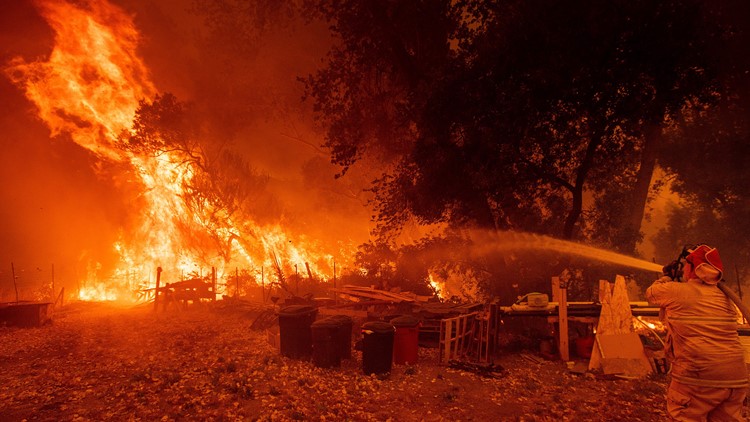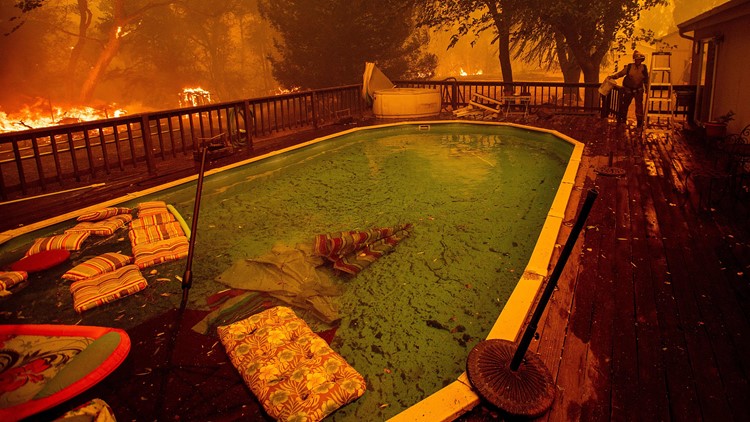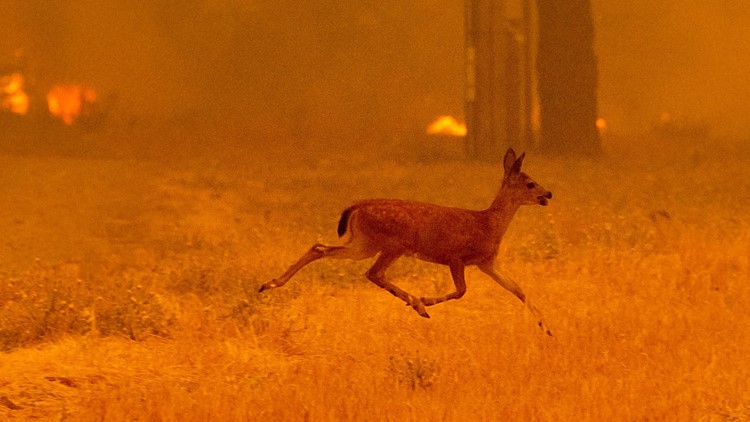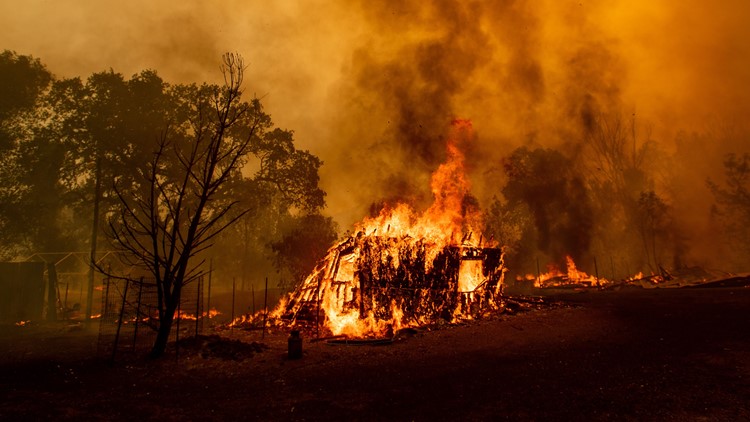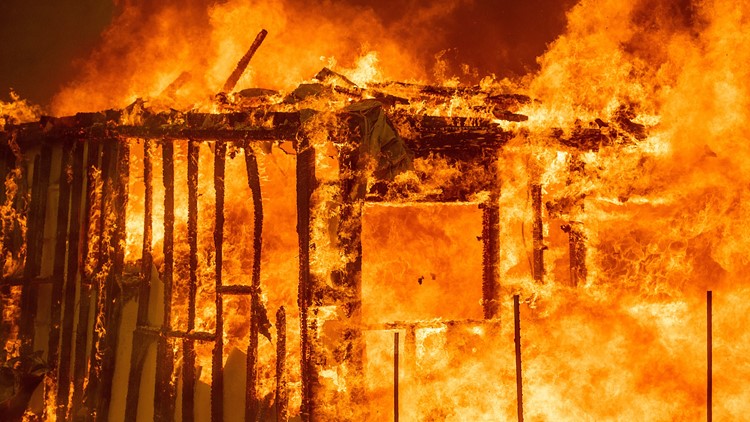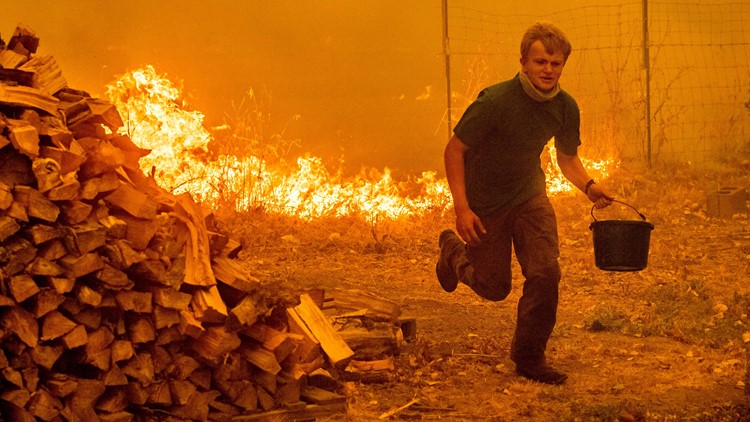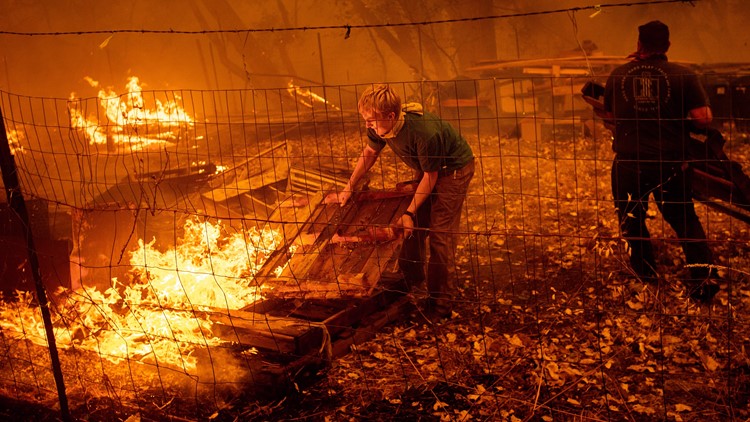If you're viewing on the ABC10 App, tap here for multimedia.
LAKEPORT, Calif. (AP) — Twin Northern California blazes fueled by dry vegetation and hot, windy weather grew Monday to become the largest wildfire in state history, becoming the norm as climate change makes the fire season longer and more severe.
The two fires burning a few miles apart and known as the Mendocino Complex are being treated as one incident. It has scorched 443 square miles (1,148.4 square kilometers), fire officials said Monday.
The fires, north of San Francisco, have burned 75 homes and is only 30 percent contained.
The size of the fires surpasses a blaze last December in Southern California that burned 440.5 square miles (1,140.8 kilometers). It killed two people, including a firefighter, and destroyed more than 1,000 buildings before being fully contained on Jan. 12.
Hotter weather attributed to climate change is drying out vegetation, creating more intense fires that spread quickly from rural areas to city subdivisions, climate and fire experts say. But they also blame cities and towns that are expanding housing into previously undeveloped areas.
More than 14,000 firefighters are battling over a dozen major blazes throughout California, state Department of Forestry and Fire Protection spokesman Scott McLean said.
"I can remember a couple of years ago when we saw 10 to 12,000 firefighters in the states of California, Oregon and Washington and never the 14,000 we see now," he said.
Crews did make progress over the weekend against one of the two blazes in the Mendocino Complex with help from water-dropping aircraft, Cal Fire operations chief Charlie Blankenheim said in a video on Facebook.
But the other one is growing after spreading into the Mendocino National Forest.
The complex of fire has been less destructive to property than some of the other wildfires in the state because it is mostly raging in remote areas. But officials say the twin fires threaten 11,300 buildings and some new evacuations were ordered over the weekend as the flames spread.
A new fire erupted Monday in Orange County, south of Los Angeles, and prompted the evacuation of two canyons and some campgrounds as it expanded into the Cleveland National Forest. By nightfall, the fire had burned 4,000 acres (6 square miles or 16 square kilometers) of chaparral-covered hillsides and destroyed one building.
Farther north, crews gained ground against a deadly blaze that has destroyed more than 1,000 homes in and around Redding. It was nearly halfway contained, Cal Fire said.
The wildfire about 225 miles (360 kilometers) north of San Francisco started more than two weeks ago by sparks from the steel wheel of a towed-trailer's flat tire. It killed two firefighters and four residents and displaced more than 38,000 people.
Officials began allowing some residents to return to their neighborhoods. But tens of thousands of others were still evacuated.
The fires in Northern California have created such a haze of smoke in the Central Valley that Sacramento County health officials advised residents to avoid outdoor activities for the entire week.
Another blaze that ignited last week has damaged a historic Northern California resort in the Stanislaus National Forest. The nearly century-old Dardanelle Resort has sustained massive structural damage, though the details were unclear, the Sacramento Bee newspaper reported.
The rustic lodge 180 miles (290 kilometers) east of San Francisco is nestled in the Sierra Nevada mountains and offers cabin and motel rentals along with RV sites, a store and restaurant.
The U.S. Forest Service reported that the fire crossed a highway Sunday evening, forcing crews to retreat from the fire's edge.
The resort owners said in a Facebook post that "at this point it has been confirmed that there is 'massive structural damage.' We are heartbroken and struggling with this news."
4 p.m. Update:
LAKEPORT, Calif. (AP) — Twin Northern California blazes fueled by dry vegetation and hot, windy weather grew Monday to become the second-largest wildfire in state history, becoming the norm as climate change makes the fire season longer and more severe.
The two fires burning a few miles apart and known as the Mendocino Complex have scorched 428 square miles (1,108 square kilometers) since igniting July 27 about 100 miles (161 kilometers) north of San Francisco, the state's firefighting agency said.
The blazes are likely to surpass the largest California wildfire on record, which burned 440 square miles (1,140 square kilometers) in December. It killed two people, including a firefighter, and destroyed more than 1,000 buildings before being fully contained on Jan. 12.
Hotter weather attributed to climate change is drying out vegetation, creating more intense fires that spread quickly from rural areas to city subdivisions, climate and fire experts say. But they also blame cities and towns that are expanding housing into previously undeveloped areas.
More than 14,000 firefighters are battling over a dozen major blazes throughout California, state Department of Forestry and Fire Protection spokesman Scott McLean said.
"I can remember a couple of years ago when we saw 10 to 12,000 firefighters in the states of California, Oregon and Washington and never the 14,000 we see now," he said.
Crews did make progress over the weekend against one of the two blazes in the Mendocino Complex with help from water-dropping aircraft, Cal Fire operations chief Charlie Blankenheim said in a video on Facebook.
But the other one is growing after spreading into the Mendocino National Forest.
The complex of fires, which has burned 75 homes, has been less destructive to property than some of the other wildfires in the state because it is mostly raging in remote areas. But officials say the twin fires threaten 9,000 buildings and some new evacuations were ordered over the weekend as the flames spread.
Farther north, crews gained ground against a deadly blaze that has destroyed more than 1,000 homes in and around Redding. It was nearly halfway contained, Cal Fire said.
The wildfire about 225 miles (360 kilometers) north of San Francisco started more than two weeks ago by sparks from the steel wheel of a towed-trailer's flat tire. It killed two firefighters and four residents and displaced more than 38,000 people.
Officials began allowing some residents to return to their neighborhoods. But tens of thousands of others were still evacuated.
Another blaze that erupted last week has damaged a historic Northern California resort in the Stanislaus National Forest. The nearly century-old Dardanelle Resort has sustained massive structural damage, though the details were unclear, the Sacramento Bee newspaper reported.
The rustic lodge 180 miles (290 kilometers) east of San Francisco is nestled in the Sierra Nevada mountains and offers cabin and motel rentals along with RV sites, a store and restaurant.
The U.S. Forest Service reported that the fire crossed a highway Sunday evening, forcing crews to retreat from the fire's edge.
The resort owners said in a Facebook post that "at this point it has been confirmed that there is 'massive structural damage.' We are heartbroken and struggling with this news."
2:45 p.m. Update:
Additional areas impacted by the Mendocino Complex Fire are seeing evacuations lifted.
Monday, 1 p.m. Update:
Several areas impacted by the Mendocino Complex Fire are seeing evacuations being lifted.
The Mendocino County evacuation warning for the following areas are being lifted: South of Mill Creek Road in Talmage, east of the Russian River, east of Old River Road, and Hwy. 101 in Hopland; all areas north of Mendocino-Sonoma County Line; and all areas west of the Mendocino-Lake County Line.
The Lake County evacuation advisory for the following areas are being lifted: South of 11th Street and Riggs Road; west of Clear Lake, Highland Springs Road, and Big Valley Road; north of the Lake-Mendocino County Line; and east of the Lake-Mendocino County Line.
Original Story
The two wildfires that make up the Mendocino Complex Fire grew over the weekend to become the second largest wildfire in the state's history.
The latest update from Cal Fire notes that total containment actually decreased to 30 percent, down from 33 percent the previous day. The number of structures threatened by the fire has decreased, as well, from over 15,000 on Sunday to 9,300 Monday morning. Seventy five residences have been destroyed.
Of the two fires that makeup the Mendocino Complex Fire, the River Fire, which has burned over 48,000 acres, has the largest containment, sitting at 58 percent contained. The Ranch Fire, which has burned over 225,000 acres, sit at only 21 percent contained.
PHOTOS: The Mendocino Complex Fire
According to Cal Fire, the Ranch Fire continues to grow in the north and south eastern directions, "threatening communities in the fire's path." Mandatory evacuations are still in place for areas in Lake, Colusa, and Mendocino County.
At 273,664 acres burned, the Mendocino Complex Fire now sits at number two of California's largest wildfires. The Thomas Fire from 2017 is the largest, having burned 281,893 acres.

